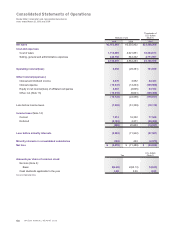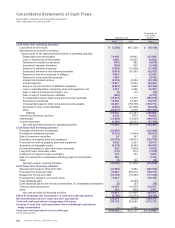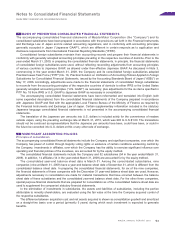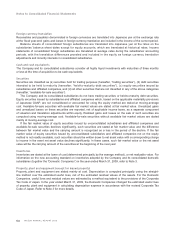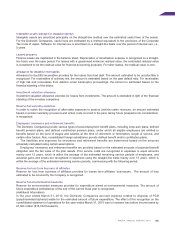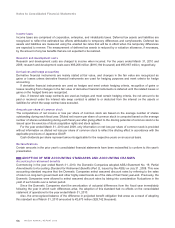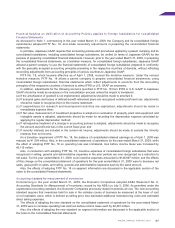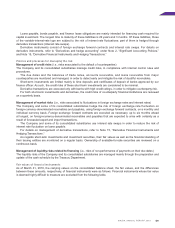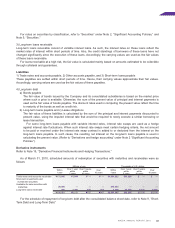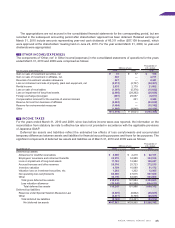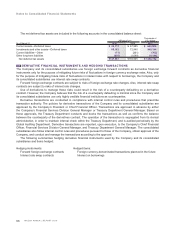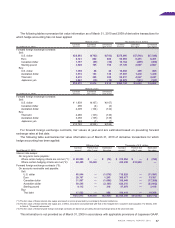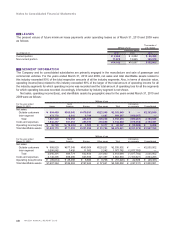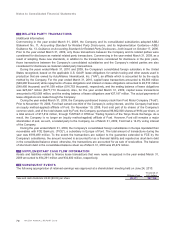Mazda 2010 Annual Report Download - page 62
Download and view the complete annual report
Please find page 62 of the 2010 Mazda annual report below. You can navigate through the pages in the report by either clicking on the pages listed below, or by using the keyword search tool below to find specific information within the annual report.
60
Millions of yen Thousands of U.S. dollars
As of March 31, 2010
Carrying
values
Fair
values Difference Carrying
values
Fair
values Difference
Assets
1) Trade notes and accounts receivable ¥ 172,489 ¥ — ¥ — $ 1,854,720 $ — $ —
Allowance for doubtful receivables (*1) (791) — — (8,505) — —
Trade notes and accounts receivable, net 171,698 171,650 (48) 1,846,215 1,845,699 (516)
2) Short-term investments and investment securities
Available-for-sale securities 25,779 25,779 — 277,194 277,194 —
3) Long-term loans receivable (*2) 5,971 — — 64,204 — —
Allowance for doubtful receivables (*3) (2,850) — — (30,645) — —
Long-term loans receivable, net 3,121 3,121 — 33,559 33,559 —
¥ 200,598 ¥ 200,550 ¥ (48) $ 2,156,968 $ 2,156,452 $ (516)
Liabilities
1) Trade notes and accounts payable ¥ 271,118 ¥ 271,118 ¥ — $ 2,915,247 $ 2,915,247 $ —
2) Other accounts payable 17,777 17,777 — 191,151 191,151 —
3) Short-term loans payable 80,836 80,836 — 869,204 869,204 —
4) Long-term debt 641,292 648,464 7,172 6,895,613 6,972,731 77,118
¥1,011,023 ¥1,018,195 ¥7,172 $10,871,215 $10,948,333 $77,118
Derivative instruments (*4)
(a) Hedge accounting not applied ¥ 614 ¥ 614 ¥ — $ 6,602 $ 6,602 $ —
(b) Hedge accounting applied (2,434) (2,434) — (26,172) (26,172) —
¥ (1,820) ¥ (1,820) ¥ — $ (19,570) $ (19,570) $ —
(*1) Allowance for doubtful receivables, which is recognized on the basis of each individual accounts receivable, is deducted.
(*2) Long-term loans receivable include those due within one year, which are included in “other current assets” on the consolidated balance sheet.
(*3) Allowance for doubtful receivables, which is recognized on the basis of each individual long-term loans receivable, is deducted.
(*4) Receivables and payables resulting from derivative transactions are offset against each other and presented on a net basis; when a net liability results,
the net amount is shown in ().
The financial instruments in the following table are excluded from “Assets 2) Short-term investments and
investment securities” in the above table because measuring the fair value of these instruments is deemed highly
difficult: market prices of these instruments are not available and future cash flows from these instruments are not
contracted.
Millions of yen
Thousands of
U.S. dollars
As of March 31, 2010 Carrying values Carrying values
Available-for-sale securities
Non-listed equity securities ¥ 3,186 $ 34,258
Investment in securities of affiliated companies 77,055 828,548
¥80,241 $862,806
Basis of measuring fair value of financial instruments
The fair values of some financial instruments are based on market prices. When market prices are unavailable, the
fair values are based on reasonably estimated values. The estimated values may vary depending on the assumptions
and variables used in the estimation.
Assets
1) Trade notes and accounts receivable
The fair values of these receivables are calculated by grouping the receivables according to their time to maturity,
and then by discounting the amount of those receivables by group to present values. The discount rates used in
computing the present values reflect the time to maturity as well as credit risk.
2) Short-term investments and investment securities
Short-term investments consist mainly of certificate of deposits of creditworthy financial institutions and are settled
within short periods of time. Hence, their carrying values approximate their fair values. Accordingly, carrying values
are used as the fair values of these investments.
As for listed stocks included in investment securities, their quoted prices on the stock exchange are used as their
fair values.


